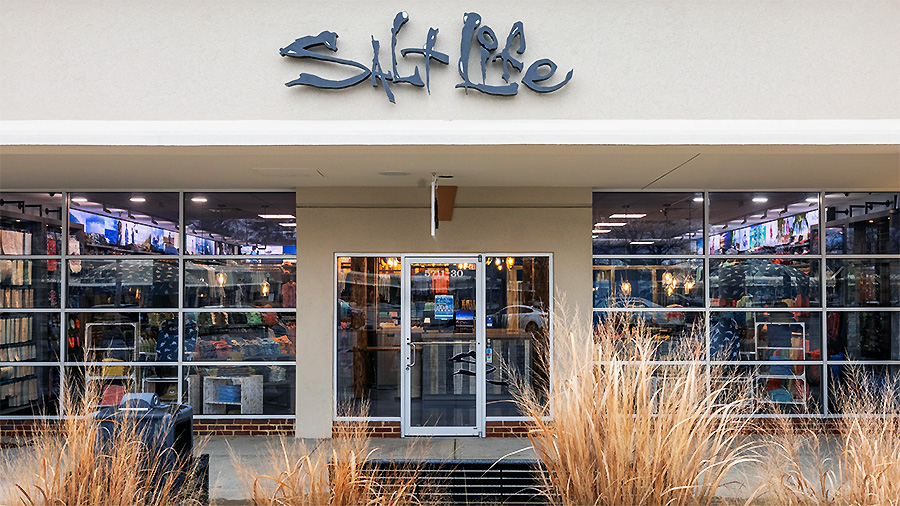Delta Apparel, Inc. reported net sales of $79.9 million for the first quarter ended December 30, a 25.5 percent decline compared to prior-year period net sales of $107.3 million.
“Many of the unfavorable market dynamics we saw across our business and the activewear industry last year persisted during our first quarter,” commented Chairman and CEO Robert W. Humphreys. “We continued to take decisive action to improve our balance sheet and streamline our cost structure and operations. Our debt and inventory levels were down more than 20 percent year-over-year and we are very near completion of our plan to reduce our offshore manufacturing footprint down to two countries and consolidate production in our more efficient Central American platform. We completed similar consolidation work in our DTG2Go digital print business and significantly reduced other areas of our workforce to better align our cost structure with the lower demand we continue to see across much of our business.
Salt Life Group segment net sales were $10.3 million and up slightly compared to the prior-year period. Humphreys said the Salt Life business registered sales growth for the quarter on the strength of its direct-to-consumer channels, and its recently opened retail location in Virginia has exceeded expectations to date.
Delta Group segment net sales were $69.6 million, down 28. 2 percent compared to $97.0 million in the prior-year period. In Activewear, DLA said it continued to see sluggish overall activity across its three go-to-market channels and the excess global manufacturing capacity in the market continued to drive pricing pressure. On-quality performance and other operational metrics in its DTG2Go business continued to improve and shipments in its digital-first business were above our internal plan, but overall demand during the holiday season came in below original forecasts.”
Gross margins were 10.9 percent of sales in the most recent quarter, compared to 12.7 percent in the prior-year period, said to be driven primarily by production curtailments (Production Curtailment Costs). Adjusted for the cost impacts of these product curtailments, first-quarter gross margins were 12.6 percent of sales.
- Delta Group segment gross margins were 5.8 percent in Q1, compared to 7.8 percent in the prior-year period. Adjusted for the Production Curtailment Costs, Delta Group segment gross margins were 8 percent; and
- Salt Life Group segment gross margins were 45.4 percent in fiscal Q1 versus 57.0 percent in the prior-year period. Salt Life’s gross margins for the quarter were negatively impacted to some degree by the timing of inventory receipts, which should reverse in the second quarter.
Selling, general and administrative expenses (SG&A) decreased from $18.9 million in the prior-year period to $18.6 million, while SG&A as a percentage of sales increased over the prior-year period to 23.3 percent.
Operating loss increased from $2.6 million in the prior-year period to an operating loss of $4.9 million in fiscal Q1. Adjusting for the Production Curtailment Costs and costs associated with the restructuring of the company’s offshore manufacturing footprint down to two countries and related initiatives (Restructuring Costs), operating loss was $2.8 million.
- Delta Group segment operating income improved from $0.1 million to $0.5 million. Adjusted for the Production Curtailment Costs and Restructuring Costs, Delta Group segment operating income was $2.7 million, or 3.8 percent of sales.
- The Salt Life Group segment experienced an operating loss of $2.1 million, compared to operating income of $0.3 million in the prior-year period.
Net interest expense was $3.6 million compared to $2.9 million in the prior-year period, with the increase driven by the elevated interest rate environment partially offset by lower borrowings.
Earnings before interest, taxes, depreciation and amortization (EBITDA) was a loss of $1.3 million. Adjusted for the Production Curtailment Costs and Restructuring Costs, EBITDA was positive at $853 thousand. Delta Group segment EBITDA was $3.5 million. Adjusted for the Production Curtailment Costs and Restructuring Costs, Delta Group segment EBITDA was $5.7 million. Salt Life Group segment EBITDA was a loss of $1.6 million.
Net loss increased to $8.5 million, or a loss of $1.22 per share, from a loss of $3.6 million, or a loss of 51 cents per share. Adjusted for the Production Curtailment Costs and Restructuring Costs, net loss was $6.6 million, or $0.94 per share.
Net inventory as of December 30, 2023, was $196.3 million, a sequential decrease of almost $16 million, or 8 percent, from September 2023 and a year-over-year decrease of $62.5 million, or 24 percent, from December 2022.
Debt outstanding under the company’s U.S. revolving credit facility was $110.8 million at December 30, 2023, a reduction of $31.5 million from the prior year December and $42.3 million from March 2023. Total net debt, including capital lease financing and cash on hand, was $144.4 million as of December 30, 2023, an approximately 26 percent reduction from $194.3 million at March 2023 and an approximately 22 percent reduction from $185.2 million at December 2022.
Cash on hand and availability under the company’s U.S. revolving credit facility totaled $7.4 million as of December 30, 2023, a decrease of $19.8 million from December 2022 and $6.8 million from September 2023.
“We believe we will need to obtain additional liquidity in the near term to fund our operations and meet the obligations specified in our U.S. revolving credit facility, and we are currently exploring a variety of options toward that end,” the company stated in a press release.
Capital spending was $300,000 during the first quarter compared to $2.1 million during the prior year first quarter.
Humphreys concluded, “With the challenging start to our fiscal year and demand across most of our markets generally expected to be flat relative to last year, we remain tightly focused on managing liquidity and working capital across all aspects of our business and will continue to look for areas where we can generate efficiencies and further streamline operations. We will also continue to evaluate strategic options with the best interest of our shareholders in mind and remain committed to monetizing our real estate portfolio through a sale-leaseback transaction for the right value proposition.”
Image courtesy Delta Apparel/Salt Life
















